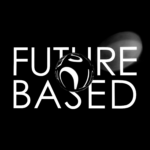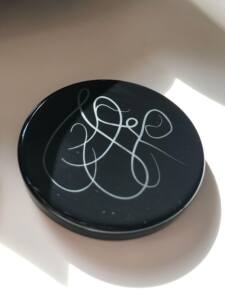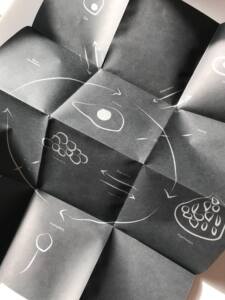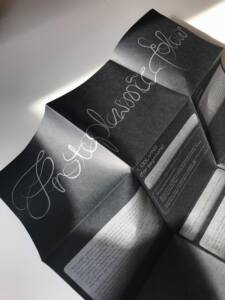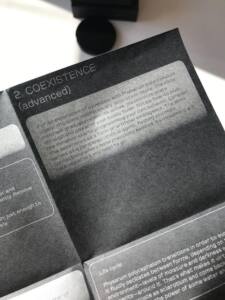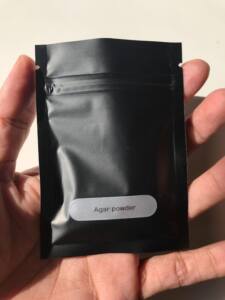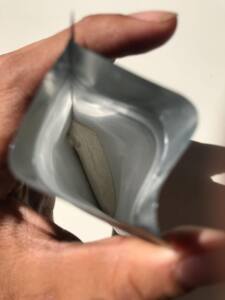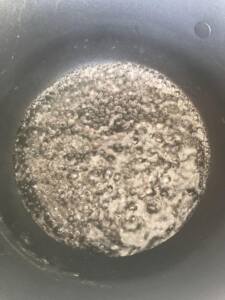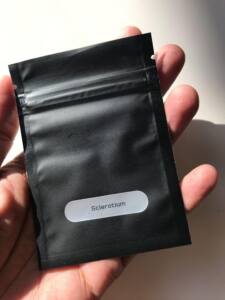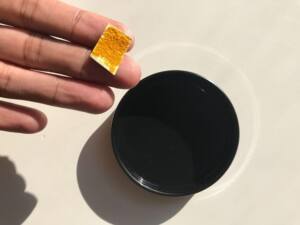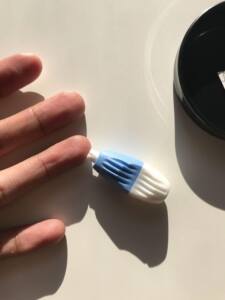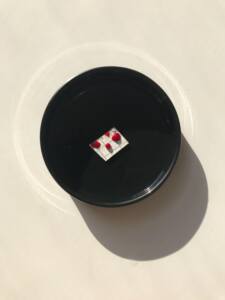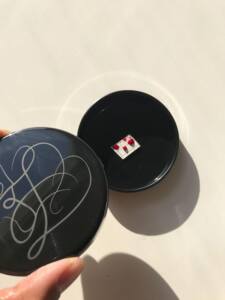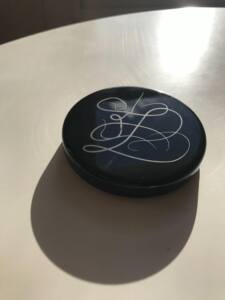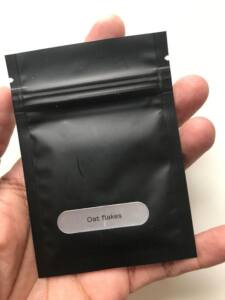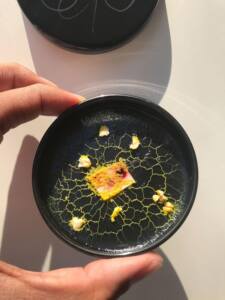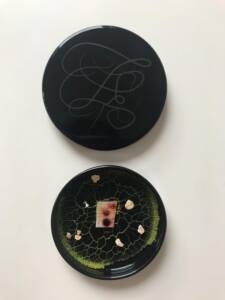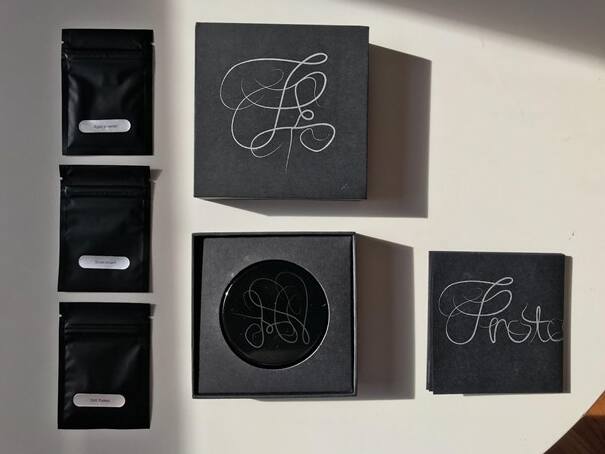
The Symbiocene Anthology is a series of alternative artists books reviews by Oscar Salguero relating to the way in which we adapt or immerse ourselves into a post-anthropocene reality. Coined by philosopher Glenn Albrecht, the Symbiocene appeals to a new generation of humans aiming for symbiotic possibilities with nature and the various entities with whom we share this planet. This is the first review of the series, future reviews will be posted here.
PROTOPLASMIC FLOW – by Oscar Salguero
A black mailer envelope arrives from Milan, Italy on October 4, 2021. The label announces a content list which includes the words “petri dish” and “poster.” Samara Editions is an Italian publishing experiment that focuses on performances via post. Each edition is the result of a unique collaboration with a different artist. The one I received is their second project to date and is called Protoplasmic Flow by Jenna Sutela. The original performance took place from June 24 to August 22, 2021, and participants were able to pick up the box locally at Mattatoio, an art center in Milan.
Protoplasmic Flow: The movement of the fluid substance (cytoplasm) within a plant or animal cell. The motion transports nutrients, proteins, and organelles within cells.1
Opening the package reveals a black box with the words “Protoplasmic Flow” on one side and “Jenna Sutela” on the other. I am familiar with Sutela’s work. She is a Berlin-based, Finnish artist working with emerging technologies at the intersection of artificial and non-human intelligences. About two years ago, I read with deep fascination Orgs: From Slime Mold to Silicon Valley and Beyond (Garret Publications, 2017), a book she edited and which focused on decentralized organisms and organizations. In fact, Orgs also came in a limited edition run that included a sample of dried Physarum polycephalum. With the Samara Editions box, I finally have a chance to experience how a dormant specimen may arrive in an artist edition.
Physarum polycephalum: literally the ‘many-headed’ slime mold, is a giant multi–nucleated but unicellular protist. The enormous size of the cell, the easy method of in vitro cultivation, the unique life cycle and its highly visible internal cytoplasmic streaming have made it invaluable for investigations on cell cycle regulation, differentiation, cytoskeleton and locomotion. 2
It is a sunny day in Brooklyn, October 12, the rare bright days of early Fall. I spread the contents on the table: a black petri dish with a beautiful alien inscription on its lid, a double-sided poster with a silver-ink graphic depicting the life cycle of the Sclerotium specimen on one side, and a series of instructions on the other. Finally, there are 3 black packets with the labels “agar powder,” “oat flakes,” and “sclerotium.”
In a “choose your own adventure” moment, I am faced with 2 possibilities. Option 1: “Coliving (for beginners),” implies the use of all three bags in order to create an environment favorable for the growth of the slime mold in the petri dish. Option 2: “Coexistence (advanced),” suggests that the performer shall ingest the specimen and become one with it. I have never grown a specimen in a petri dish before and I am curious to witness that, so I go with Option 1. The performance begins.
Step 1: Prepare the agar plate. This is achieved by adding the agar powder to boiling water, and then pouring the mix into the petri dish until it solidifies. Done.
Step 2: Collect a few drops of your own saliva or blood, the water of life. I have prepared a lancet, which is a leftover object from a previous food allergies test I performed called “At-Home Food Sensitivity Test” and provided by a laboratory called Everlywell. In a sense, it is another bioart performance by post, though admittedly more invasive (not only physically, but in terms of data health privacy). I am mentally preparing to give a part of myself to this organism, a piece of my blood. I pierce the tip of my left annular finger. I forgot to warm up so the blood is not flowing as rapidly as I imagined. I am forced to soak the back of the paper holding the slime mold with my blood. I place 4 full droplets. Done.
Step 3: Place the dormant slime mold into the agar plate. By now I have mixed the order of things, so I just proceed to place the blood soaked specimen at the center of the dish. I close the lid and put it at the top of a shelf overnight, a dark and cool area.
Steps 4 to 5 essentially ask to feed the organism starting the morning after. This part of the performance reflects something very personal as the slime mold organism, just as myself, relies on the consumption of oat flakes. In the last 2 months I’ve experienced an episode of uncontrollable acid reflux and as part of the natural treatment, I consume oats twice a day (morning and night) along with oat milk.
Reflux: to flow back or return.3
I return to see the organism a number of times in the next few days, I sprinkle a small number of oats onto the agar. It continues to expand. It begins to creep up to the upper lid, beyond its agar bed. The red continues a bit intensely in the middle, I have inadvertently created a heart, which pumps life into the system. It is a spectacle of life. A delicate balance of darkness and nutrition that goes on for 2 weeks. At some point the petri dish is no longer large enough for the outward reach of its protoplasmic flow. The yellow is intense and more so under the shiny sunlight.
Step 6: Continue to hatch or release. After several days, I decide to release this being into a corner of Carroll Park where it will expand and morph into the green bed or the adjacent flowers. It deserves an existence beyond a cold black dish, it is from out there and wants me to let it back out there. I am unsure what this ecosystem will provide to it, but I am convinced its intelligence will take it where it needs to go, a performance that now belongs to cosmic chance. When I came back home I realized I also released my own DNA with it, and that’s ok. End of performance.
—
In an alternative ending, I have consumed a part of this slime mold, whose color is not unlike the tone of natural acid reflux. Sclerotium has decided to grow within my organism, be part of me and has manifested through these words, a multi-cephalum entity inside a single cephalus body. Is this the third mind that William Burroughs insinuated? Born from two autonomous beings and now organic imagination beyond the two. In this new mode, the performance advances to a level I can no longer comprehend…
The book can be purchased here.
Note: Future Based has no financial benefits/sponsorship from any book sales that came about through these series. Furthermore, Future Based is not liable for matters relating to ordering and sending the book.
